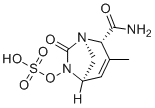
Durlobactam
CAS No. 1467829-71-5
Durlobactam( Durlobactam )
Catalog No. M12004 CAS No. 1467829-71-5
Durlobactam is a novel beta-lactamase inhibitor for treatment of resistant bacterial infections.
Purity : >98% (HPLC)
 COA
COA
 Datasheet
Datasheet
 HNMR
HNMR
 HPLC
HPLC
 MSDS
MSDS
 Handing Instructions
Handing Instructions
| Size | Price / USD | Stock | Quantity |
| 5MG | 2043 | Get Quote |


|
| 50MG | 4122 | Get Quote |


|
| 100MG | 5760 | Get Quote |


|
| 200MG | Get Quote | Get Quote |


|
| 500MG | Get Quote | Get Quote |


|
| 1G | Get Quote | Get Quote |


|
Biological Information
-
Product NameDurlobactam
-
NoteResearch use only, not for human use.
-
Brief DescriptionDurlobactam is a novel beta-lactamase inhibitor for treatment of resistant bacterial infections.
-
DescriptionDurlobactam is a novel beta-lactamase inhibitor for treatment of resistant bacterial infections.
-
In Vitro——
-
In Vivo——
-
SynonymsDurlobactam
-
PathwayGPCR/G Protein
-
TargetAntibacterial
-
RecptorAntibacterial
-
Research Area——
-
Indication——
Chemical Information
-
CAS Number1467829-71-5
-
Formula Weight277.251
-
Molecular FormulaC8H11N3O6S
-
Purity>98% (HPLC)
-
Solubility——
-
SMILESO=S(O)(ON1[C@]2([H])C=C(C)[C@@H](C(N)=O)[N@@](C2)C1=O)=O
-
Chemical Name(1R,2S,5R)-2-carbamoyl-3-methyl-7-oxo-1,6-diazabicyclo[3.2.1]oct-3-en-6-yl hydrogen sulfate
Shipping & Storage Information
-
Storage(-20℃)
-
ShippingWith Ice Pack
-
Stability≥ 2 years
Reference
molnova catalog



related products
-
Erythromycin estolat...
Erythromycin estolate
-
ANT431
ANT431 is a novel potent metallo-β-lactamase (MBL) inhibitor with IC50 of 290 nM and 195 nM for NDM-1 and VIM-2.
-
Bicyclomycin benzoat...
A broad spectrum antibiotic active against Gram-negative bacteria and the Gram-positive bacterium.



 Cart
Cart
 sales@molnova.com
sales@molnova.com


